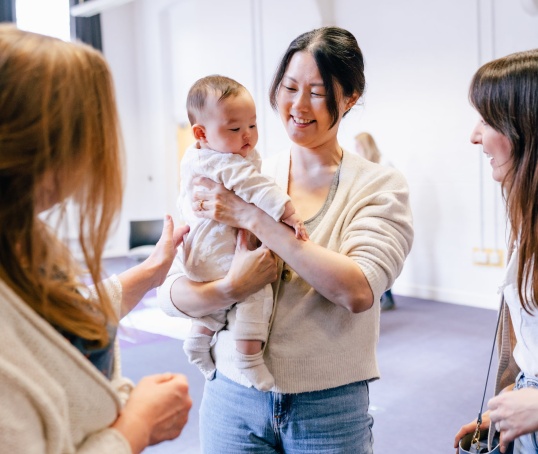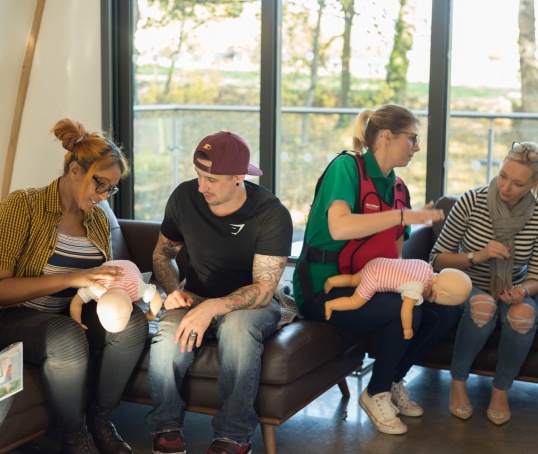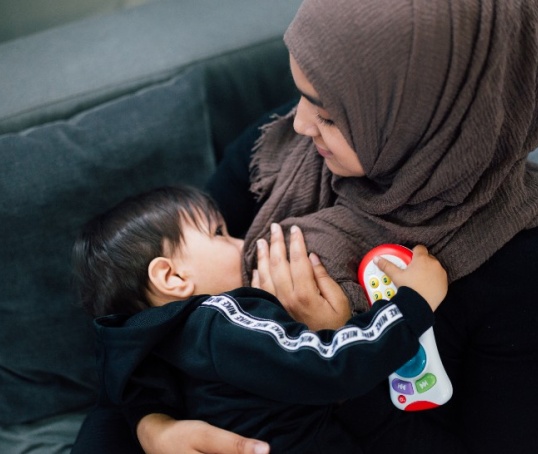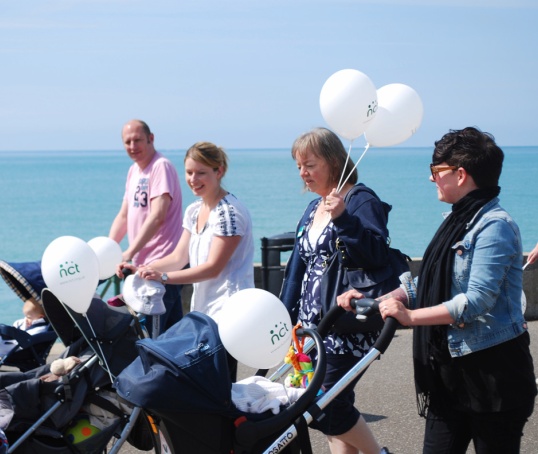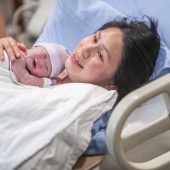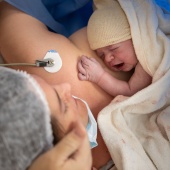You might be wondering how your baby’s position will impact on the birth. We talk you through the positions your baby might be in and what it could mean for labour.
How to know what position the baby is in
From the 24 week appointment in pregnancy, the midwife will be checking the position of your baby (NHS, 2023). Your baby is likely to continue changing position until around 37 weeks when it is expected to settle (RCOG, 2014).
There are a few different positions that your baby can be lying in (Viccars, 2003):
Occiput Anterior (OA)
This is the most common position. The baby is head down in the parent’s womb and the crown of their head (occiput) is at the front (anterior).
If the baby is lying to the left, it is called Left Occiput Anterior (LOA)
If the baby is lying to the right, it is called Right Occiput Anterior (ROA)
Occiput Posterior (OP)
This is when the baby is head down and facing the front, so in a ‘back-to-back' position with the parent.
Occiput Transverse (OT)
This is when the baby is lying at a right angle across the parent’s abdomen.
Breech
Breech is when the baby is lying bottom down in the womb.
Oblique
Oblique is when the baby is lying at an angle.
Unstable lie
This is when the baby doesn’t settle into a usual position after 37 weeks.
Ideally, at the end of pregnancy, the baby’s chin will be tucked into their chest. This means the narrowest part of their head (the occiput or crown) presses on the cervix, helping it to open (Hofmeyr & Moreri-Ntshabele, 2024; Simkin, 2010; Viccars, 2003).
Can you tell at home where the baby is in the womb?
It’s not easy to accurately assess the position of a baby in the womb without an ultrasound. In one study, ultrasound confirmed that only 16 out of 100 baby positions described by midwives were correct (Webb et al, 2011).
However, it is possible at home to get an idea of how your baby is lying. If there’s a dip in the belly when the pregnant woman or person lies down, your baby might be back-to-back (Simkin, 2011).
While resting, imagine the belly in four quarters (Simkin, 2011):
- Which side is firm? This might be where your baby’s torso is lying
- A big bulge will be your baby’s head or bottom
- If the pregnant woman or person feels stretching this is probably leg movements
- Where kicking is felt, it might be your baby’s knees or feet
- Smaller movements might be hands or elbows
What does the baby’s position mean for birth?
The position might affect your plans for birth (NICE, 2023; RCOG, 2014).
- Transverse lie means your baby is sideways. You may be offered birth in hospital with doctors and possibly a caesarean.
- Breech position may involve turning the baby, having a caesarean, or continuing with a vaginal birth.
- Unstable lie might also mean that you will be offered birth in hospital with doctors present.
What does it mean if the baby is ‘back-to-back'?
Most babies who are ‘back-to-back’ (OP) at the start of labour turn into a better position during labour (Reed, 2016; Simkin, 2010).
In a study of babies who were all OP at the start of labour (Othenin-Girard et al, 2018):
- 20 in 100 were born by caesarean before or during labour
- 61 in 100 rotated to an OA or forwards position during labour
- 19 in 100 were born OP
If your baby is OP, recent research suggests that the labour is likely to be longer as the baby has further to turn. This can be exhausting and may raise the likelihood of having a caesarean birth (Eide et al, 2024; Gaillongo et al, 2024; Othenin-Girard et al, 2018).
However, in the past, having a baby in the OP position wasn’t thought to be a problem. Some specialists feel it is modern maternity practices and beliefs that have led to longer, slower labours (Reed, 2016).
For example, back pain is common in labour, regardless of the baby’s position. There is no evidence that back pain is more severe when the baby is back-to-back (Lee et al, 2015). It might help to consider that labour might be different, rather than better or worse (Reed, 2016). Medical care will be available if needed.
Can a baby’s position be changed?
Research shows that a parent’s positions during pregnancy can change the space within the pelvis (Reitter et al, 2014; Hemmerich et al, 2019). However, there is no strong proof that this changes the baby’s position at the end of pregnancy (Hofmeyr & Moreri-Ntshablele, 2024).
Rather than trying to move the baby, it can be beneficial for the pregnant woman or parent to try and ease tension in their body. This could increase symmetry and create space which allows the baby to move (Oleksy et al, 2019; O’Brien, 2022; Andrew, 2010; Siccardi et al, 2019).
People with previous injuries to their pelvis or legs may benefit from physical therapy or exercise to address any imbalance. Those with strong pelvic muscles or who are inactive might also find it helpful. Some ideas for helping to ease tension might be (O’Brien, 2022):
- brisk walking for 30 mins each day
- pregnancy yoga
- sitting with hips higher than knees
- swimming
- wearing low shoes and calf stretching
- getting up and moving every 30 mins
- wearing the right size bra to help the diaphragm move
- eating a healthy diet to avoid constipation
- seeing a physical therapist, osteopath or chiropractor trained in pregnancy to address any old injuries.
Further information
Our NCT infant feeding line offers practical and emotional support with feeding your baby and general enquiries for parents, members and volunteers: 0300 330 0700.
We also offer antenatal courses which are a great way to find out more about birth, labour and life with a new baby.
Make friends with other parents-to-be and new parents in your local area and see what NCT activities are happening nearby.
Andrew CG. (2010) Considering non-optimal fetal positioning and pelvic girdle dysfunction in pregnancy: increasing the available space. Journal of Clinical Chiropractic Pediatrics. 11(2):783-788. http://jccponline.com/jccp_v11_n2.pdf [6 Aug 24]
Eide B, Sande RK, Von Brandis P, Kessler J, Tappert C, Eggebø TM. (2024) Associations between fetal position at delivery and duration of active phase of labor: A historical cohort study. Acta Obstet Gynecol Scand. ; 00: 1-10. https://doi.org/10.1111/aogs.14929
Gaillongo E. Webster AC. (2024) Perinatal outcomes in persistent occiput posterior fetal position: a systematic review and meta-analysis. BJM. 32(2). https://www.britishjournalofmidwifery.com/content/literature-review/per… [6 Aug 24]
Hemmerich A, Bandrowska T, Dumas GA. (2019) The effects of squatting while pregnant on pelvic dimensions: A computational simulation to understand childbirth. J Biomech. 18;87:64-74. https://doi.org/10.1016/j.jbiomech.2019.02.017
Hofmeyr GJ, Moreri-Ntshabele B. (2024) Maternal postures for fetal malposition in late pregnancy for improving the health of mothers and their infants. Cochrane Database Syst Rev. 8;2(2):CD014616. https://doi.org/10.1002/14651858.CD014616
NHS (2023) Your antenatal care. https://www.nhs.uk/pregnancy/your-pregnancy-care/your-antenatal-care/ [7 Aug 24]
NICE (2023) Intrapartum care [NG235]. https://www.nice.org.uk/guidance/ng235 [7 Aug 24]
Lee N, Kildea S, Stapleton H (2015) ‘Facing the wrong way’: Exploring the Occipito Posterior position/back pain discourse from women׳s and midwives perspectives, Midwifery, 31(10) 1008-1014. https://doi.org/10.1016/j.midw.2015.06.003
O’Brien M (2022) Biomechanics for birth. [Online course] https://www.optimalbirth.co.uk/ [29 Oct 22]
Oleksy, Łukasz; Mika, Anna; Kielnar, Renata; Grzegorczyk, Joanna; Marchewka, Anna; Stolarczyk, Artur. (2019) The influence of pelvis reposition exercises on pelvic floor muscles asymmetry: A randomized prospective study. Medicine 98(2):p e13988. https://doi.org/10.1097/MD.0000000000013988
Othenin-Girard V, Boulvain M, Guittier MJ. (2018) Occiput posterior presentation at delivery: Materno-foetal outcomes and predictive factors of rotation. Gynecologie, Obstetrique, Fertilite & Senologie. 46(2):93-98. https://doi.org/10.1016/j.gofs.2017.11.006
RCOG (2014) Green top guidelines No. 50. Umbilical cord prolapse. https://www.rcog.org.uk/guidance/browse-all-guidance/green-top-guidelin… [7 Aug 24]
Reed R (2016) In celebration of the OP baby. https://midwifethinking.com/2016/06/08/in-celebration-of-the-op-baby/ [7 Aug 24]
Simkin P. (2010) The fetal occiput posterior position: state of the science and a new perspective. Birth. 37(1):61-71. https://doi.org/10.1111/j.1523-536X.2009.00380.x
Simkin P (2011) The Labour progress handbook. 3rd edition. Chichester. Wiley-Blackwell.


